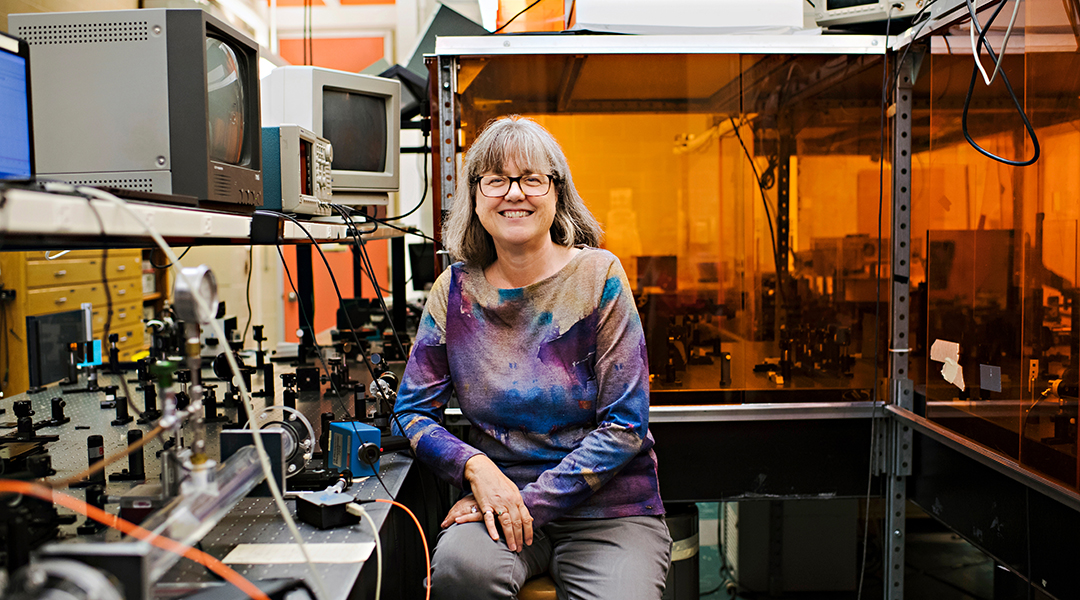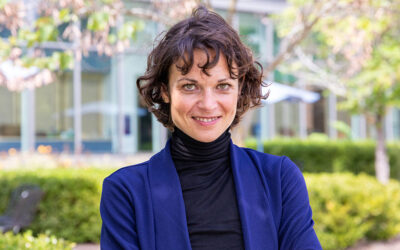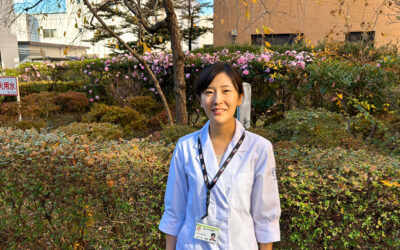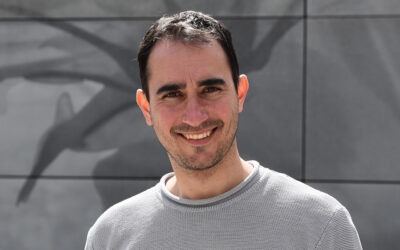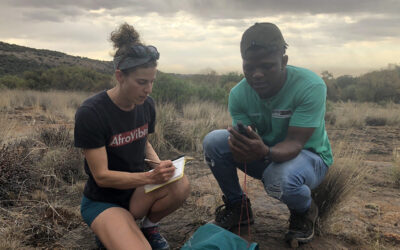Almost five years after winning the Nobel Prize in Physics, Donna Strickland, Canadian physicist and professor at the University of Waterloo, says it’s been a whirlwind. “My life is completely different,” she said during our interview. “I wasn’t expecting it at all.”
Earlier this month, Strickland was visiting Vienna and Berlin as part of the Lise Meitner Lectures hosted by the German Physical Society, and had a brief window in which she was available to speak with members of the press. Receiving an invitation to interview a Nobel Laureate is an exciting prospect, and while waiting for her arrival, I’ll admit my nerves were running high. But Strickland immediately put the room at ease with her friendly and easy-going attitude. “Oh, you got doughnuts!” she said upon arriving. “Is that because I’m Canadian?”
She now receives countless invitations to speak around the world, has met rock stars, the Pope, astronauts, and during her Berlin lecture, showed a picture from the Nobel banquet in which she was seated and enthusiastically gesturing next to the King of Sweden. “I don’t remember what I was explaining, but it wasn’t physics,” she said, laughing. “These people are not necessarily going to remember meeting me, but I’ll remember meeting them. [As a laureate], you have these experiences that a normal scientist doesn’t have.”
The morning of the announcement, she received a call at 5:15 AM alerting her to the fact that she had just won a Nobel Prize. “After the announcement, my email just went ‘ding, ding, ding, ding, ding’, and emails came in from all around the world. People that I had not heard from since elementary school were getting in touch, and then the media requests started coming in,” she said.
“Unlike at a university like Stanford, where there are media people that stay awake until the announcement to find out if [someone from the university] is going to win (because they do so often), Waterloo has never won one before, so my communications person didn’t wake up until 7:00 AM. From six to seven, I was by myself trying to answer media questions, and I didn’t know what I was doing.
“It was a hectic morning; I had plumbers there who had to shut my water off, I had my neighbor there with a big bouquet of flowers, I had a photographer trying to take pictures, and I had The Globe and Mail, Canada’s big newspaper, on the phone with me. It was crazy.”
A winning idea: Chirped pulse amplification
Strickland’s win came as a result of her pioneering work on ultra-short yet extremely high-intensity laser pulses, which she and her Ph.D. supervisor at the University of Rochester, Gérard Mourou, dubbed “chirped pulse amplification”. This work was published in her debut paper in 1985. “I was the first person who needed the [laser] pulse to be short with high power,” she said during her lecture given the next day. “I had to make the special laser.”
From their application in surgery, to smartphone technology, LiDAR systems, barcode scanners, and fiber optics, lasers play a major role in numerous areas of our lives. For many applications, a laser’s power — the amount of energy it emits over a given time — matters.
It’s long been known that when a laser’s light intensity (how much power is concentrated in a given area) reaches a point after which it begins to behave in ways that classical physics cannot explain, creating interesting effects. The more power you have, the more intensity that is available, and the more atypical behaviors known as nonlinear optical phenomena that can be explored.
However, in the 1960s, scientists hit a wall in their efforts to produce lasers with ever-increasing intensity. At a certain level, laser light cannot be intensified further due to a phenomenon known as Kerr-lens self-focusing. This effect occurs when a high-intensity laser is focused through a medium and causes its refractive index to change, which leads to even tighter beam focus over a smaller area. While this has some valuable application in areas such as laser cutting, it prevented scientists from increasing laser intensity without causing damage to the equipment.
Chirped pulse amplification helped break through this barrier by diluting laser light so that it can be amplified to a larger total power without reaching the same harmful intensities. It does so by first stretching laser pulses through time by introducing “chirp” into the signal. This is done using a prism or a diffraction grating to disperse the laser pulse into its constituent colors, sending the longer wavelengths first and the shorter wavelengths last. This stretching reduces the intensity of the pulse, which is passed through an amplifier, and then through a reversed set of gratings to recombine the longer and shorter wavelengths into a single pulse that now has amplified power with intensities impossible to achieve safely using direct amplification.
Since 2001, over 24 million corrective eye surgeries have been carried out using Strickland and Mourou’s high pulse laser. “Chirped pulse amplification changed power by orders of magnitude, and it changed how light and matter interact,” she said during the interview. “I was trying to do a high order, nonlinear optical experiment, we wanted to see if we could push [the laser] higher.
“We knew it would be big in the field of high-intensity laser physics, but I don’t think we thought our applications lead to a Nobel Prize.”
Making science accessible
Strickland’s lecture, unofficially titled, “Why was I the lucky student that won the Nobel Prize?“, was captivating. She managed to make complex scientific concepts accessible to a general audience (much appreciated as a non-physicist myself), while weaving in entertaining anecdotes.
For instance, she shared the amusing story of how one night her lab mate had clandestinely climbed through the building’s air ducts to bring the fiber cables she needed into the lab where she was conducting her experiments. She also recounted the time when she had to unspool 2.2 km of fiber in order to ensure that the laser light was indeed coming out at the other end, only to discover that she had broken it 1.4 km in. “Keep on going, don’t let little things stop you,” was her advice to the audience.
Strickland has been vocal in the past about the need for scientists to communicate their work to the general public in order to increase scientific literacy and understanding. “I don’t think [the public] needs to know really technical physics, but they need to understand the role of science in society, and I don’t know that people nowadays in North America really understand it,” she said.
“When I’ve traveled to Asia, I’ve been very impressed with how in tune they are with their scientists. I was amazed that during the Nobel Prize week, there was a Japanese winner my year, and he was surrounded by six to eight Japanese media people the entire week, not just the day he won — I don’t know how he didn’t lose his mind but I thought, ‘Oh my goodness, this guy is like a rock star in Japan’.
“Years ago, I told my kids when they were in high school that I was famous, and my kids said if you want to think you’re famous, then go ahead,” she said laughing. “And when I won the Nobel Prize I asked, can I say it now?
“[But] no American or Canadian media came to Sweden, and I started to really think about how different Asia looks at science compared to North America, and I think we could learn something from that. I think the public needs to understand how much science can help the economy — Korea is my favorite example of how much they’ve used science to boost their economy.
“I have also been dismayed at how too many people now think about science from a political point of view, which is so bizarre because most scientists would say there should be no politics in science. Depending on your politics, you do or don’t believe in climate change, or you would or wouldn’t wear a mask during COVID-19, and I think we have to start letting people know more about the scientific process so they can think for themselves what’s best.”
A societal shift
As one of only four women to have ever won the Nobel Prize in Physics in the award’s 100-year-plus history, questions around gender equity and the underrepresentation of women in STEM inevitably surface.
An editorial published in Nature Reviews Physics stated that despite progress being made in recent years, “the under-representation of women in science, and in particular in physics, is profound enough that we don’t need detailed statistics to see its existence.”
In an interview held during Nobel Prize week, Strickland described not having had a female professor, as either an undergrad or graduate student. “Now, there are six of us, I believe, in my department of 40,” she said. “That is still only […] 15% and it is not as high as it should be, but the fact that there are even six women instead of zero is quite a change.”
Numerous studies have explored the factors that lead to these trends in spite of sustained investments and supported efforts to improve the representation of girls and women in STEM. The problem is multi-faceted and complex, and according to Strickland, requires a significant societal shift to really address it.
“In order to change the ratio of men and women in the natural sciences, society would have to care,” said Strickland during our interview. “People often ask why I think more women don’t do physics and […] the only time I ever heard an explanation that made sense to me was when one of my male colleagues said, ‘Well, what do we do physics for? It’s not for the money, we don’t get paid as well as other fields. It’s so we can go to our conferences to say, look what I did!’ And men are taught from birth to stand up and say, ‘Look what I did!’, and women are not.”
“Until we change that and make that a great goal of ours, [the gender ratio] will stay the same,” she added.
What’s next?
All the events that have taken place over the last five years have been surreal and strange for someone who’s tried to have a quiet life, commented Strickland. “I’m still trying to make sure the pulses are efficient,” she said. “I have a colleague right next door [at Waterloo] who, maybe 20 years ago, I told I would try to make single femtosecond laser pulses to do his molecular movies.
“He’s still waiting, basically it’s gone nowhere because I’m never in the lab anymore. But I’m still working towards it, whether I achieve it or not, I’m not sure.”
She also described a collaboration with Toshi Tajima, the pioneering theoretical plasma physicist currently working at the University of California, Irvine, known for his work with John M. Dawson in 1979 on Laser Wakefield Acceleration — a method for producing high-energy electron beams. To date, this method has found application in radiography, radioisotope production, nuclear physics, and the possible transmutation of nuclear waste.
“The number one use of big lasers, ” explained Strickland, “is for use in Wakefield Acceleration. [Tajima] now wants to do it at low levels with my fiber lasers to see if we can use […] acceleration of electrons to remove tumors.”
Tumor removal using accelerated electrons usually requires surgeons to cut into layers of healthy tissue to ensure that no cancerous tissue has been left behind. “They err on the side of taking too much, but that can cause problems,” said Strickland. “[Tajima] hopes that we could use [my] lasers to leave the last layer. I will have nothing to do with the medical application — I don’t go anywhere near medicine because I don’t like squishy — but I am trying to make a new type of fiber source that will stay short and intense right out of the fiber and not need gradient compressors.
“I’m also trying to fill that gap where there are very few sources just for the fun of it. I figure, if I do it people will come and use them. I just like to have lasers that nobody else has.”
Feature image credit: University of Waterloo

